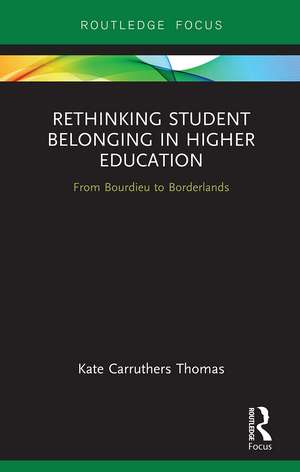Rethinking Student Belonging in Higher Education: From Bourdieu to Borderlands
Autor Kate Carruthers Thomasen Limba Engleză Paperback – 29 aug 2022
Bringing theoretical insights into institutional areas of policy and practice, this book:
- considers what it means to belong as a non-traditional student in a higher education environment designed for traditional students;
- presents the argument for belonging in line with theoretical insights of Bourdieu, Brah and Massey;
- illustrates belonging through case studies drawn from empirical research; and
- presents the argument for a borderland analysis of belonging in higher education, identifying key features and advantages of this theoretical framework.
| Toate formatele și edițiile | Preț | Express |
|---|---|---|
| Paperback (1) | 124.15 lei 6-8 săpt. | |
| Taylor & Francis – 29 aug 2022 | 124.15 lei 6-8 săpt. | |
| Hardback (1) | 423.09 lei 6-8 săpt. | |
| Taylor & Francis – 4 dec 2018 | 423.09 lei 6-8 săpt. |
Preț: 124.15 lei
Preț vechi: 147.91 lei
-16% Nou
Puncte Express: 186
Preț estimativ în valută:
23.76€ • 25.80$ • 19.96£
23.76€ • 25.80$ • 19.96£
Carte tipărită la comandă
Livrare economică 22 aprilie-06 mai
Preluare comenzi: 021 569.72.76
Specificații
ISBN-13: 9781032401751
ISBN-10: 1032401753
Pagini: 98
Dimensiuni: 138 x 216 x 9 mm
Greutate: 0.45 kg
Ediția:1
Editura: Taylor & Francis
Colecția Routledge
Locul publicării:Oxford, United Kingdom
ISBN-10: 1032401753
Pagini: 98
Dimensiuni: 138 x 216 x 9 mm
Greutate: 0.45 kg
Ediția:1
Editura: Taylor & Francis
Colecția Routledge
Locul publicării:Oxford, United Kingdom
Public țintă
Postgraduate and ProfessionalCuprins
Abbreviations; Prologue; Chapter 1: Who belongs in higher education?; Chapter 2: The part-time landscape; Chapter 3: A journey into border territory; Chapter 4: Borderlands and belonging; Chapter 5: Thinking spatially; Chapter 6: A simultaneity of stories-so-far; Epilogue
Notă biografică
Kate Carruthers Thomas is a Senior Research Fellow at Birmingham City University, UK.
Descriere
Arguing for an understanding of belonging in higher education as relational, particularly in reference to ‘non-traditional’ students, this book counters prevailing normative assumptions as to what it means to belong and how institutional policy is shaped and implemented around traditional students.
